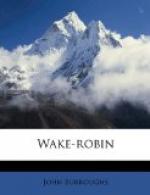Nearly every high projecting rock in any range has one of these nests. Following a trout stream up a wild mountain gorge, not long since, I counted five in the distance of a mile, all within easy reach, but safe from the minks and the skunks, and well housed from the storms. In my native town I know a pine and oak clad hill, round-topped, with a bold, precipitous front extending halfway around it. Near the top, and along this front or side, there crops out a ledge of rocks unusually high and cavernous. One immense layer projects many feet, allowing a person or many persons, standing upright, to move freely beneath it. There is a delicious spring of water there, and plenty of wild, cool air. The floor is of loose stone, now trod by sheep and foxes, once by Indian and wolf. How I have delighted from boyhood to spend a summer day in this retreat, or take refuge there from a sudden shower! Always the freshness and coolness, and always the delicate mossy nest of the phoebe-bird! The bird keeps her place till you are within a few feet of her, when she flits to a near branch, and, with many oscillations of her tale, observes you anxiously. Since the country has become settled this pewee has fallen into the strange practice of occasionally placing its nest under a bridge, hayshed, or other artificial structure, where it is subject to all kinds of interruptions and annoyances. When placed thus, the nest is larger and coarser. I know a hay-loft beneath which a pair has regularly placed its nest for several successive seasons. Arranged along on a single pole, which sags down a few inches from the flooring it was intended to help support, are three of these structures, marking the number of years the birds have nested there. The foundation is of mud with a superstructure of moss, elaborately lined with hair and feathers. Nothing can be more perfect and exquisite than the interior of one of these nests, yet a new one is built every season. Three broods, however, are frequently reared in it.
The pewees, as a class, are the best architects we have. The kingbird builds a nest altogether admirable, using various soft cotton and woolen substances, and sparing neither time nor material to make it substantial and warm. The green-crested pewee builds its nest in many instances wholly of the blossoms of the white oak. The wood pewee builds a neat, compact, socket-shaped nest of moss and lichens on a horizontal branch. There is never a loose end or shred about it. The sitting bird is largely visible above the rim. She moves her head freely about and seems entirely at her ease,—a circumstance which I have never observed in any other species. The nest of the great-crested flycatcher is seldom free from snake skins, three or four being sometimes woven into it.




